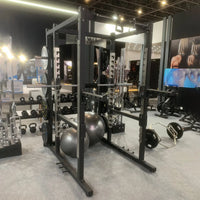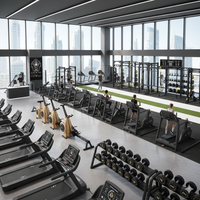For anyone shopping for a new treadmill, the specifications page can feel like a cryptic language filled with baffling acronyms. Horsepower (HP), Continuous Horsepower (CHP), duty cycles—what does it all mean, and how does it determine whether a machine will last a lifetime or burn out after a few months of intense use?
The answer lies in understanding the fundamental difference between commercial gym equipment and your average home gym equipment. It all comes down to the motor, the true heart of the machine, and its ability to handle constant, varied stress.
The Heart of the Machine: Horsepower vs. Continuous Horsepower
The most commonly advertised, yet often misleading, motor spec is Horsepower (HP). Many budget treadmills tout a high "Peak HP" number, which is simply the maximum power the motor can generate for a short burst (usually a few seconds). It’s an impressive figure, but it’s essentially irrelevant for sustained running.
The metric you must prioritize is Continuous Horsepower (CHP).
-
CHP Defined: Continuous Horsepower is the power level the motor can maintain consistently over an extended period without overheating. This is the true measure of a treadmill motor’s stamina and durability.
-
The Durability Rule: A motor with a high CHP rating (e.g., 3.0 CHP or higher) is engineered to run cooler and more efficiently under load. This means less internal friction, less thermal stress, and a significantly longer lifespan. When looking for high-quality home gym equipment, 2.5 CHP should be the absolute minimum for walking, and 3.0 CHP or higher is necessary for frequent, sustained running.
What Makes Commercial Gym Equipment 'Commercial'?
The demands placed on a treadmill in a commercial setting are extreme. It must operate for 12 to 18 hours a day, catering to users ranging from 100-pound walkers to 300-pound sprinters. This environment requires the motor to be fundamentally different from its home-grade counterpart.
Commercial gym equipment motor specs typically include:
-
High CHP (4.0 CHP and above): Commercial motors are massive, designed to handle the frictional heat generated by heavy, fast, and continuous use.
-
Superior Cooling Systems: These motors feature robust internal cooling fans and often use higher-quality wire insulation and larger components to dissipate heat effectively. Heat is the number one killer of treadmill motors, so superior cooling translates directly into superior durability.
-
Advanced Incline Motor: The motor that drives the incline feature is often a high-torque, heavy-duty component, designed for thousands of adjustments per week.
A commercial treadmill is built like a tank because the financial cost of a breakdown is high—it impacts member satisfaction and requires expensive service. Every component, from the motor casing to the circuit board, is over-engineered for reliability.
The Reality of Home Gym Equipment
The term home gym equipment covers a vast spectrum, from compact, entry-level machines to near-commercial equivalents. A home-grade treadmill is designed for a completely different "duty cycle."
The typical home-use scenario is: one user, 30–60 minutes per day, a few times a week. The motor does not need to handle multi-user demands or all-day operation.
-
Lower CHP is Acceptable: A 2.5–3.0 CHP motor is often perfectly adequate for a single runner or family of walkers. It will be smaller, lighter, and often quieter than its commercial cousin.
-
Focus on Features: Home models often prioritize features that enhance the user experience, such as larger touchscreens, integrated training programs, and aesthetic design, sometimes at the expense of raw motor power.
-
Noise Level: A key advantage of modern, well-built home gym equipment is the low noise level, crucial for use in shared living spaces where a noisy, underpowered motor can easily disrupt others.
Durability is the Duty Cycle
The most telling specification that links the motor to the machine’s durability is the Duty Cycle. This refers to the motor’s ability to run continuously at its rated CHP before needing a rest to cool down.
A true commercial gym equipment motor is designed for an almost 100% duty cycle, meaning it can run indefinitely without self-destructing. The motors in high-end, heavy-duty home treadmills approach this standard.
A budget treadmill motor, however, will have a limited duty cycle. If you push a low-CHP motor for too long, especially with a heavy user or high-speed running, the internal temperature climbs exponentially, ultimately leading to failure—a trip and a smoking smell are typical warning signs. When comparing two seemingly similar treadmills, the heavier one with the higher CHP is nearly always the one with the superior duty cycle.
The Deck and Belt Factor
It’s important to remember that the motor doesn't operate in a vacuum. Its longevity is directly tied to the components it drives. A powerful motor bolted to a flimsy deck and small rollers will still burn out prematurely.
-
Rollers: Larger rollers (2.5 inches or more) require fewer revolutions to move the belt, reducing strain and heat on both the belt and the motor. Commercial gym equipment always uses large rollers.
-
Running Deck: Commercial decks are thicker and often coated with wax, reducing the friction the motor must overcome.
Ultimately, whether you are running a multi-million-dollar fitness centre or carving out a dedicated corner for your fitness routine, the principle is the same: the motor must be powerful enough to handle your max load and run time comfortably. Prioritising continuous Horsepower and overall component quality over peak power claims ensures you are investing in a durable, long-lasting treadmill that supports your fitness Lifestyle.




0 comments